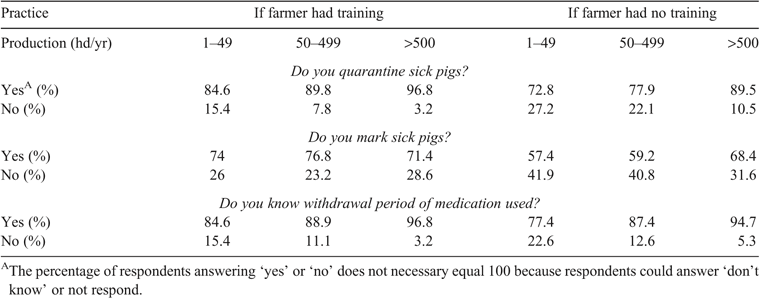China’s village pig industry: training influences handling of sick pigs and awareness of medication withdrawal periods
B. J. Lohmar A , D. Wang B , J. Huang B and M. P. Boddington C DA U.S. Grains Council, Beijing Office, China World Trade Centre, Beijing, China.
B Center for Chinese Agricultural Policy, Beijing, China.
C Asian Agribusiness Consulting, Suite B209 Bai Jia Zhuang Commercial Centre, Beijing, China.
D Corresponding author. Email: michael@boddingtonconsulting.com
Animal Production Science 55(12) 1535-1535 https://doi.org/10.1071/ANv55n12Ab114
Published: 11 November 2015
According to Korves (2015), China produces half of the world’s pork and imports the largest volume of pork globally. Gale et al. (2012) reported that China’s pork industry continues to be volatile and whilst there are a growing number of large, modern producers, the bulk of production still takes place on millions of farms in China’s villages. China’s swine industry has been affected in recent years by disease outbreaks and food safety scandals that have not only generated volatile price swings but also have negative impacts on the image of the industry and on consumers’ trust in pork products. These incidents not only affect farmers’ profits and overall efficiency of the industry, but also adversely affect the reputation of the industry and its products. The purpose of this paper is to report the findings from a survey that aimed to provide an understanding of the impact that farmer (defined as the person managing and handling the pigs) training had on current practices of managing sick pigs, the use of medication at the village level, and opportunities to improve herd health and food safety in China’s pork industry.
In 2013 a face-to-face survey was conducted with 557 swine producers (139 small, 279 medium and 139 large) across 90 villages in five provinces (Guangzhou, Sichuan, Hubei, Shandong, and Jilin). The results presented in this paper focus on aspects of disease management and are a sub-set of the data collected in the larger survey of village pork producers.
Farmers with training were more likely to know and employ basic health and safety practices than farmers without training (Table 1). As the production of pigs increased the percentage of famers quarantining sick pigs and their awareness of medication withdrawal periods increased. However, the practice of marking sick pigs was less prevalent on the larger herds.

|
The key outcome of this survey was that regardless of size, training had an impact on food safety practices such as quarantining sick pigs and knowledge of withdrawal periods albeit a diminishing effect as herds sizes increased. Education and reinforcement needs to continue to occur in China in order to improve the safety and thus consumer confidence of domestically produced pork.
References
Gale F, Marti D, Hu DH (2012) China’s Volatile Pork Industry, USDA, LDP-M-211-01, February.Korves R (2015) USDA Report Analyses China’s Pork Industry, USDA (Farms.com, May).


